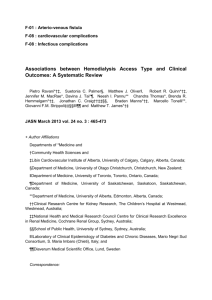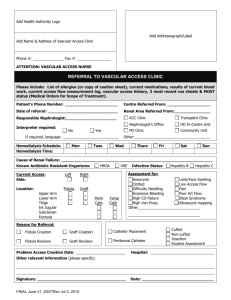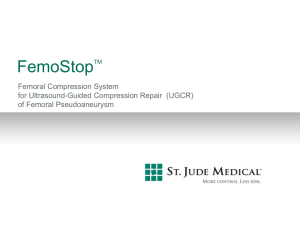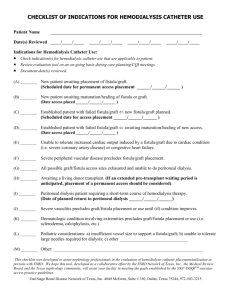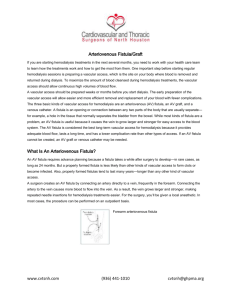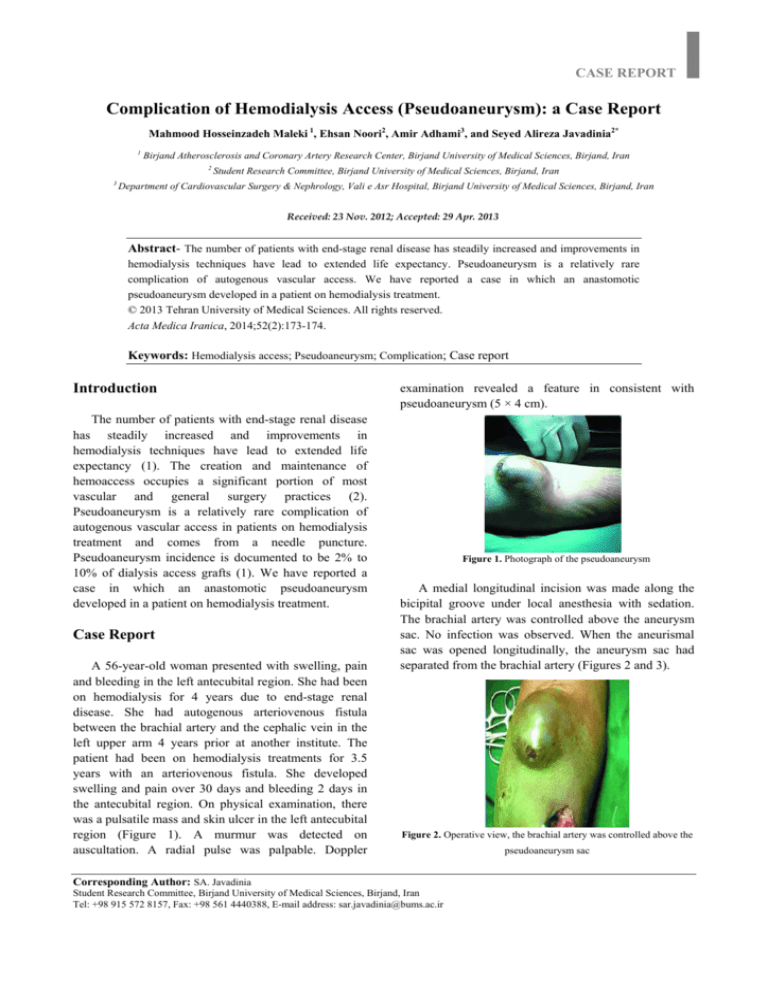
CASE REPORT
Complication of Hemodialysis Access (Pseudoaneurysm): a Case Report
Mahmood Hosseinzadeh Maleki 1, Ehsan Noori2, Amir Adhami3, and Seyed Alireza Javadinia2*
1
Birjand Atherosclerosis and Coronary Artery Research Center, Birjand University of Medical Sciences, Birjand, Iran
2
3
Student Research Committee, Birjand University of Medical Sciences, Birjand, Iran
Department of Cardiovascular Surgery & Nephrology, Vali e Asr Hospital, Birjand University of Medical Sciences, Birjand, Iran
Received: 23 Nov. 2012; Accepted: 29 Apr. 2013
Abstract- The number of patients with end-stage renal disease has steadily increased and improvements in
hemodialysis techniques have lead to extended life expectancy. Pseudoaneurysm is a relatively rare
complication of autogenous vascular access. We have reported a case in which an anastomotic
pseudoaneurysm developed in a patient on hemodialysis treatment. © 2013 Tehran University of Medical Sciences. All rights reserved.
Acta Medica Iranica, 2014;52(2):173-174.
Keywords: Hemodialysis access; Pseudoaneurysm; Complication; Case report
Introduction
The number of patients with end-stage renal disease
has steadily increased and improvements in
hemodialysis techniques have lead to extended life
expectancy (1). The creation and maintenance of
hemoaccess occupies a significant portion of most
vascular and general surgery practices (2).
Pseudoaneurysm is a relatively rare complication of
autogenous vascular access in patients on hemodialysis
treatment and comes from a needle puncture.
Pseudoaneurysm incidence is documented to be 2% to
10% of dialysis access grafts (1). We have reported a
case in which an anastomotic pseudoaneurysm
developed in a patient on hemodialysis treatment.
Case Report
A 56-year-old woman presented with swelling, pain
and bleeding in the left antecubital region. She had been
on hemodialysis for 4 years due to end-stage renal
disease. She had autogenous arteriovenous fistula
between the brachial artery and the cephalic vein in the
left upper arm 4 years prior at another institute. The
patient had been on hemodialysis treatments for 3.5
years with an arteriovenous fistula. She developed
swelling and pain over 30 days and bleeding 2 days in
the antecubital region. On physical examination, there
was a pulsatile mass and skin ulcer in the left antecubital
region (Figure 1). A murmur was detected on
auscultation. A radial pulse was palpable. Doppler
examination revealed a feature in consistent with
pseudoaneurysm (5 × 4 cm).
Figure 1. Photograph of the pseudoaneurysm
A medial longitudinal incision was made along the
bicipital groove under local anesthesia with sedation.
The brachial artery was controlled above the aneurysm
sac. No infection was observed. When the aneurismal
sac was opened longitudinally, the aneurysm sac had
separated from the brachial artery (Figures 2 and 3).
Figure 2. Operative view, the brachial artery was controlled above the
Corresponding Author: SA. Javadinia
Student Research Committee, Birjand University of Medical Sciences, Birjand, Iran
Tel: +98 915 572 8157, Fax: +98 561 4440388, E-mail address: sar.javadinia@bums.ac.ir
pseudoaneurysm sac
Complication of Hemodialysis Access… Figure 3. Operative view, white arrow shows clot in pseudoaneurysm
Distal backflow was optimal. The defect in the
brachial artery was repaired primarily and the distal end
of the vein was ligated. The radial pulse was palpable
postoperatively. A new arteriovenous fistula was created
on the right antecubital region.
Discussion
Improvements in hemodialysis techniques have lead
to extended life expectancy (3). Autogenous
arteriovenous fistula has considered a gold standard for
long-term hemodialysis access. An arteriovenous fistula
between the radial artery and the cephalic vein should be
the primary choice for hemodialysis (1). Arteriovenous
fistula may involve with some complications such as
prolonged bleeding, dilatation, infection, steal, swelling,
thrombosis, stenosis, and pseudoaneurysm (3-6).
Pseudoaneurysm is a relatively rare complication of
autogenous Arteriovenous fistula (5). The incidence of
Pseudoaneurysm is predicted to be 2% to 10% of
dialysis access grafts (5,7). Pseudoaneurysms most
commonly originate from needle punctures. Repeated
puncture of the graft may results in pseudoaneurysm (4).
Usage of large needles or poor and traumatic puncture
techniques can cause the formation of pseudoaneurysms
in the native vascular graft (7).
Diagnosis of pseudoaneurysm was confirmed by
Doppler examination for our patient. Progressive
enlargement of a pseudoaneurysm can interfere with
needle cannulation or lead to secondary complications
including breakdown of the overlying skin, spontaneous
bleeding, and rupture (8). The 2000 K/DOQI Guidelines
recommend surgical repair if the integrity of the overlying
skin is compromised (8). The traditional treatment of a
clinically significant pseudoaneurysm is surgical ligation
or resection of the hemodialysis access (8,9).
The presenting signs and symptoms of false
aneurysms may include neuropathy and venous
174
Acta Medica Iranica, Vol. 52, No. 2 (2014)
thrombosis from pressure on an adjacent nerve and
veins. Rupture of the false aneurysm, infection,
hemorrhage, and distal vascular insufficiency are other
possible consequence (6).
Surgical correction of graft pseudoaneurysms is
recommended based on the high incidence of
complications, such as rupture, thrombosis and
infection. The most common and dangerous
complication of the pseudoaneurysm is rupture and lifethreatening hemorrhage. If they grow to an appreciable
size, they can become painful and erode through the
skin, resulting in hemorrhage (10).
In conclusion, pseudoaneurysm of hemodialysis
access may be encountered as a rare complication of
autogenous vascular access; thus every physician should
attend to it.
References
1. Yasim A, Kabalci M, Eroglu E, et al. Complication of
hemodialysis graft: anastomotic pseudoaneurysm: a case
report. Transplant Proc 2006;38(9):2816-8.
2. Rodriguez HE, Leon L, Schalch P, et al. Arteriovenous
access: managing common problems. Perspect Vasc Surg
Endovasc Ther 2005;17(2):155-66.
3. Basaran O, Karakayali H, Emiroglu R, et al. Complications
and long-term follow-up of 4416 vascular access
procedures. Transplant Proc 2003;35(7):2578-9.
4. Katzman HE, Glickman MH, Schild AF, et al. Multicenter
evaluation of the bovine mesenteric vein bioprostheses for
hemodialysis access in patients with an earlier failed
prosthetic graft. J Am Coll Surg 2005;201(2):223-30.
5. Tashjian DB, Lipkowitz GS, Madden RL, et al. Safety and
efficacy of femoral-based hemodialysis access grafts. J
Vasc Surg 2002;35(4):691-3.
6. Yildirim S, Nursal TZ, Yildirim T, et al. Brachial artery
pseudoaneurysm: a rare complication after hemodialysis
therapy. Acta Chir Belg 2005;105(2):190-3.
7. Zibari GB, Rohr MS, Landreneau MD, et al.
Complications from permanent hemodialysis vascular
access. Surgery 1988;104(4):681-6.
8. Vesely TM. Use of stent grafts to repair hemodialysis
graft-related pseudoaneurysms. J Vasc Interv Radiol
2005;16(10):1301-7.
9. Lin PH, Johnson CK, Pullium JK, et al. Transluminal stent
graft repair with Wallgraft endoprosthesis in a porcine
arteriovenous graft pseudoaneurysm model. J Vasc Surg
2003;37(1):175-81.
10. Rabindranauth P, Shindelman L. Transluminal
stentgraft repair for pseudoaneurysm of PTFE hemodialysis
graft, J Endovasc Surg 1998;5(2):138-41.

